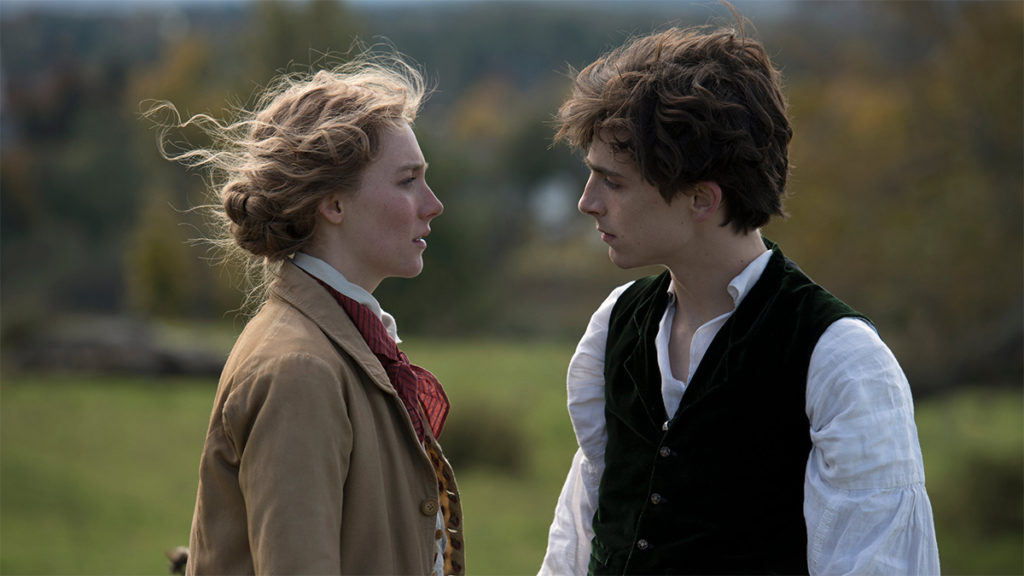Louisa May Alcott’s classic Little Women burned its way into my being when I read it four times in a row in fourth grade. My budding independent heart was ready to absorb all of the ladies and their fierce and feisty ways. It makes sense: Alcott was a feminist, an abolitionist, and her childhood home was even a stop for fugitive enslaved people on the Underground Railroad. She was not one to be traditional and most of the themes in Little Women follow that dogma pretty well — all but one detail in particular (spoilers!): the main character Jo’s marriage to Professor Friedrich Bhaer. Writer and Director Greta Gerwig’s (Lady Bird) 2019 adaptation takes some creative license with this aspect of the plot and, for me, it makes all the difference.
Before reading on, big time spoilers abound for the movie and novel.
Alcott published her first edition in two parts, which left her audience clamoring to know what happens when the little women grow and when Jo will inevitably marry her childhood friend, Laurie. In this era, there was no way Jo would end up a satisfactorily unmarried woman, even if she wanted to be. Alcott, however, wanted to thwart this narrative and leave Jo as a “literary spinster,” as Alcott was herself.
“Girls write to ask who the little women will marry, as if that was the only end and aim of a woman’s life,” she wrote in a letter to a friend. “I won’t marry Jo to Laurie to please anyone.”
In her adaptation, Gerwig mirrors the inevitable pressure Alcott faced from her publishers who insisted that Jo marry someone by the end. Alcott was forced to acquiesce but found a way to make it far less palatable to her readers: Laurie marries younger sister Amy while Jo marries the older, more dour Friedrich Bhaer. She even wrote to her friend that she was making the ending intentionally unsatisfying. It’s a loss to women that the novel is pushed into the form of some of its literary peers when the alternative, a single and successful Jo, is ripe for open interpretations as asexual, queer, or full of free love to give, to people or her creative passions.
Saoirse Ronan and Louis Garrel as Jo and Friedrich | Columbia Pictures
When it comes to veering from literary source material, I always feel it should be done intentionally and with reason. So when Gerwig subverts traditional romantic views of marriage in favor of more realistic portrayals of marriage as an “economic proposition” or an alternative to loneliness, it brings us back to reality and closer to Alcott’s probable view on the institution. We see two versions of Jo (Saoirse Ronan) play out in Sliding Doors fashion: one who embraces Friedrich (Louis Garrel) in the rain in the fictionalized narrative, and the other, an author who has clearly chosen to remain single. Although it is ambiguous whether the Jo we see with her publisher gets married, Gerwig’s choices let us assume that she doesn’t. We could even assume she never had more interaction with Friedrich at all after leaving New York. Or that she had ever met him at all.
Jo says to her publisher (Tracy Letts), “I suppose marriage has always primarily been an economic proposition. Even in fiction.” The parallels of Jo selling her marriage into fiction, Amy (Florence Pugh) seeking marriage for economic gain, and Alcott’s forced nuptial ending to the book are all part and parcel of the theme of a woman’s choices being supremely limiting and often cold, particularly in the 19th century. The happy ending we see Ronan’s Jo get is the loving stroke of the leather binding her brand new novel as it comes off of the press. We can feel her satisfaction in this particular relationship. Her fictional mirror (boy, this gets meta) gets the romantic ending demanded by that publisher back in 1868.
Saoirse Ronan and Greta Gerwig | Getty
Gerwig chose this duality as an homage to her discovery of Alcott’s original intent. On the DGA Podcast, she explained more:
“Part of what I wanted to do was 150 years later give her an ending she might have liked. I thought if we can’t do this now then we’ve really made no progress and we should all hang our heads. But the structure truly came out of wanting to introduce this layer of authorship everywhere in it, how we author our own lives even if we’re not writers and how we kind of tell and retell the story of how we became who we are.”
In a New York Times interview, Gerwig doubled down on her choice when pressured to drop the dual ending: “I never would have shot it that way. Everyone would have been like, ‘What did we just watch?’ That ending’s not in me. At all.” According to NPR, Gerwig goes so far as to gives Jo a line that Alcott said of herself, “I’d rather be a free spinster and paddle my own canoe.”
It’s clear that Gerwig respects Alcott’s feminism and her intended Little Women ending, and for those of us who also appreciate it, it’s a revelation.
